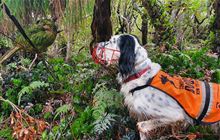Conservation Dogs Programme procedures
Introduction
National standards and procedures must be followed by dog-handler teams and relevant project managers who require a dog-handler team.Dog-handler teams must be certified under the Conservation Dogs Programme to undertake work:
- on DOC projects, or
- on public conservation land, or
- in the presence of protected species.
There are currently over 80 Conservation Dogs in New Zealand. There are many requirements to become a dog-handling team, the most important is the need for the specific dog-handler team locally and/or nationally
Programme requirements
To be accepted in the Conservation Dogs Programme, handlers must have:
- experience of working with the target protected or pest species
- dog-handling and training experience
- time and opportunity – it takes around 18 months of daily training to certify a handler and their dog. Once certified they will still need to train several times a week for the duration of the dog’s working life (up to 10 years).
Programme Certification
Deciding to become a certified protected species or pest detection dog-handler team is a serious and long term commitment. The training is rigorous and teams are required to meet a high standard to pass certification assessments and to maintain their standard at that level. Training is carried out by the dog-handler, the Conservation Dogs Programme does not have a training programme.
DOC has very few full-time dog-handler roles. Generally, handlers are either DOC staff that have a dog to assist them for some of their work, or are contractors doing conservation work.
The major steps to becoming a fully certified dog-handler team are:
- Handler application.
- Handler selection interview and acceptance into the Programme.
- Interim certificate assessment for handler and dog (tested for obedience and control, issued for 6 months before they must be tested for full certification).
- Full certificate assessment for handler and dog (tested again for obedience and control along with hunting/detection ability, issued for 3 years then re-tested).
All dogs and handlers must have an interim certificate before training can commence on protected species, or in the presence of protected species. Once trained and certified, the dogs and handlers require regular ongoing work to maintain the appropriate level of competency.
Support is available to handlers throughout the process, including advice on dog selection and training, equipment, mentoring and annual handler workshops.
Standard Operating Procedure
This Standard Operating Procedure (SOP) outlines the process for:
- accessing protected species and pest detection dog services, and
- obtaining certification for handlers and dogs.
It also provides minimum standards for dog welfare and professional behaviour.
Request a copy
To to request a copy of the SOP, contact:
Helen Neale, Manager, Conservation Dogs Programme
Email: hneale@doc.govt.nz
Disclaimer
We are making the document/s available outside DOC to share our best practice. Any use by members of the public is at their own risk and DOC disclaims all liability in reference to that risk.
The document/s were written for DOC staff and may include DOC-specific terms and reference internal documents only accessible to DOC staff. You may need further help to do the work described and also need to get authorisation. Caveats may apply.

